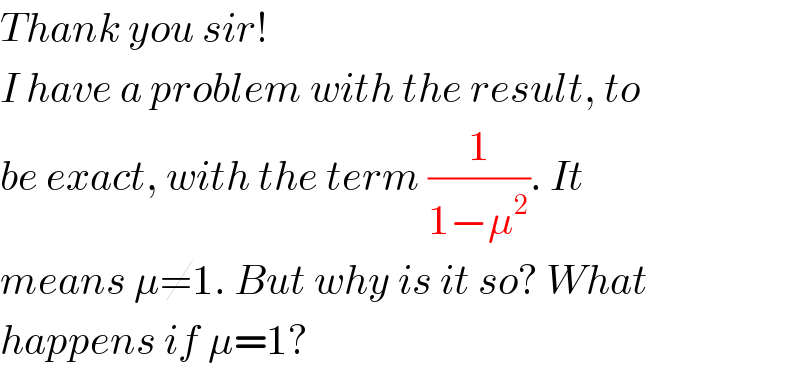
Question and Answers Forum
Question Number 27332 by ajfour last updated on 05/Jan/18

Commented by ajfour last updated on 05/Jan/18

Answered by mrW1 last updated on 05/Jan/18

Commented by mrW1 last updated on 05/Jan/18

Commented by mrW1 last updated on 06/Jan/18
![(a_2 /a_1 )=tan θ N_2 =N sin θ−f cos θ=N(sin θ−μ cos θ) mg−f_2 −N cos θ−f sin θ=ma_2 mg−μN_2 −N (cos θ+μ sin θ)=ma_2 mg−μN(sin θ−μ cos θ)−N (cos θ+μ sin θ)=ma_2 mg−N(2μsin θ−μ^2 cos θ+cos θ)=ma_2 N_1 =mg+N cos θ+f sin θ=mg+N(cos θ+μ sin θ) N sin θ−f cos θ−f_1 =ma_1 N(sin θ−μ cos θ)−μN_1 =ma_1 N(sin θ−μ cos θ)−μmg−μN(cos θ+μ sin θ)=ma_1 N(sin θ−μ^2 sin θ−2μ cos θ)−μmg=ma_1 ((mg−N(2μsin θ−μ^2 cos θ+cos θ))/(N(sin θ−μ^2 sin θ−2μ cos θ)−μmg))=((ma_2 )/(ma_1 ))=tan θ=((sin θ)/(cos θ)) mg cos θ−N(2μsin θ cos θ−μ^2 cos^2 θ+cos^2 θ)=N(sin^2 θ−μ^2 sin^2 θ−2μ sin θ cos θ)−μmg sin θ N(2μsin θ cos θ−μ^2 cos^2 θ+cos^2 θ+sin^2 θ−μ^2 sin^2 θ−2μ sin θ cos θ)=mg(cos θ+μsin θ) N(1−μ^2 )=mg(cos θ+μsin θ) ⇒N=(((cos θ+μ sin θ)mg)/(1−μ^2 )) a_1 =((N(sin θ−μ^2 sin θ−2μ cos θ))/m)−μg a_1 =(((cos θ+μ sin θ)(sin θ−μ^2 sin θ−2μ cos θ)g)/(1−μ^2 ))−μg ⇒a_1 =[(cos θ+μ sin θ)(sin θ−((2μ)/(1−μ^2 )) cos θ)−μ]g a_2 =g−((N(2μ sin θ+cos θ−μ^2 cos θ))/m) a_2 =g−(((cos θ+μ sin θ)(2μ sin θ+cos θ−μ^2 cos θ)g)/(1−μ^2 )) ⇒a_2 =[1−(cos θ+μ sin θ)(((2μ)/(1−μ^2 )) sin θ+cos θ)]g](Q27347.png)
Commented by ajfour last updated on 05/Jan/18

Commented by mrW1 last updated on 06/Jan/18

